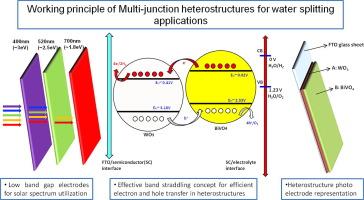Experimental study on critical role of heterostructures for efficient water splitting activity
IF 13.3
1区 工程技术
Q1 ENGINEERING, CHEMICAL
引用次数: 0
Abstract
Water splitting has the potential to generate sustainable energy through the production of green hydrogen. Metal oxides are a preferred choice for semiconductor materials in photoelectrochemical (PEC) water splitting due to their stable performance in aqueous environments, cost-effectiveness, and ease of synthesis. However, individual metal oxides have certain limitations that can be addressed through heterostructure photoelectrodes. In this study, the performance of various heterostructure metal oxides, including BiVO4, Fe2O3, Co3O4, and WO3 was investigated under similar synthesis and testing conditions. These heterostructures were selected based on their band straddling properties and multi-junction concepts, which enable efficient utilization of the solar spectrum and enhance charge carrier separation. Six distinct heterostructures (FTO/WO3/BiVO4, FTO/Fe2O3/BiVO4, FTO/WO3/Fe2O3, FTO/WO3/Co3O4, FTO/BiVO4/Co3O4, FTO/Fe2O3/Co3O4) were evaluated with a focus on optimizing band alignment for efficient charge separation and PEC performance. Larger area electrodes (4 cm2) were synthesized and tested to ensure reliable performance metrics and eliminate edge effects observed in smaller electrodes. Among the studied heterostructures, WO3/BiVO4 heterostructure achieved the highest photocurrent density (1.68 mA/cm2), while Fe2O3/Co3O4 exhibited the highest dark current density (4.95 mA/cm2). Stability tests demonstrated the robustness of these heterostructures, with FTO/WO3/BiVO4 showing a minimal ∼ 5 % photocurrent degradation over 100 h of continuous operation. Structural (XRD, XPS), optical (UV–Vis), and electrochemical (EIS, Mott-Schottky) analyses provided comprehensive insights into the superior PEC performance of these heterostructures.

求助全文
约1分钟内获得全文
求助全文
来源期刊

Chemical Engineering Journal
工程技术-工程:化工
CiteScore
21.70
自引率
9.30%
发文量
6781
审稿时长
2.4 months
期刊介绍:
The Chemical Engineering Journal is an international research journal that invites contributions of original and novel fundamental research. It aims to provide an international platform for presenting original fundamental research, interpretative reviews, and discussions on new developments in chemical engineering. The journal welcomes papers that describe novel theory and its practical application, as well as those that demonstrate the transfer of techniques from other disciplines. It also welcomes reports on carefully conducted experimental work that is soundly interpreted. The main focus of the journal is on original and rigorous research results that have broad significance. The Catalysis section within the Chemical Engineering Journal focuses specifically on Experimental and Theoretical studies in the fields of heterogeneous catalysis, molecular catalysis, and biocatalysis. These studies have industrial impact on various sectors such as chemicals, energy, materials, foods, healthcare, and environmental protection.
 求助内容:
求助内容: 应助结果提醒方式:
应助结果提醒方式:


